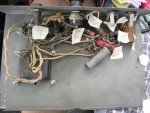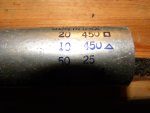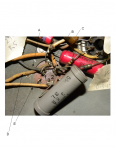littlemerl
New member
Hi
I'm working on this small 1950s Harmony guitar amp replacing all the capacitors and resistors to give it a fresh start. I haven't found a schematic for this amp so I'm looking at each component and writing down the values as well as testing the resistors as I go. I decided to cut open the cap filter can because I didn't know which value caps were where in the can and at the terminals. I found that inside the metal ribbons don't have any values on them so I am no further in understanding which new electrolytics I will put where. Here are the values in the can: 20 uf 450v, 10uf 450v and 50uf at 25v. If you look at the terminals (labeled 1,2,3) of the can inside the chasis and what wires and components connect to them can you decipher where the new electrolytic caps will go? Any help is appreciated.




Info about labeled picture:
A: black wire comes from 6v6gt tube
B: yellow wire comes from different pin on 6V6gt tube
C:Terminal on filter can I labeled 2-all three resistors in the image connect to it
D:white wire connects from transformer to ground
E: white wire connects to 5Y3 tube
I'm working on this small 1950s Harmony guitar amp replacing all the capacitors and resistors to give it a fresh start. I haven't found a schematic for this amp so I'm looking at each component and writing down the values as well as testing the resistors as I go. I decided to cut open the cap filter can because I didn't know which value caps were where in the can and at the terminals. I found that inside the metal ribbons don't have any values on them so I am no further in understanding which new electrolytics I will put where. Here are the values in the can: 20 uf 450v, 10uf 450v and 50uf at 25v. If you look at the terminals (labeled 1,2,3) of the can inside the chasis and what wires and components connect to them can you decipher where the new electrolytic caps will go? Any help is appreciated.




Info about labeled picture:
A: black wire comes from 6v6gt tube
B: yellow wire comes from different pin on 6V6gt tube
C:Terminal on filter can I labeled 2-all three resistors in the image connect to it
D:white wire connects from transformer to ground
E: white wire connects to 5Y3 tube
